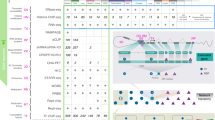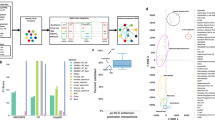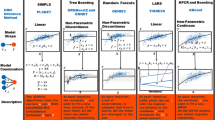Abstract
DNA microarrays have been widely applied to cancer transcriptome analysis. The Oncomine database contains a large collection of such data, as well as hundreds of derived gene-expression signatures. We studied the regulatory mechanisms responsible for gene deregulation in these cancer signatures by searching for the coordinate regulation of genes with common transcription factor binding sites. We found that genes with binding sites for the archetypal cancer transcription factor, E2F, were disproportionately overexpressed in a wide variety of cancers, whereas genes with binding sites for other transcription factors, such as Myc-Max, c-Rel and ATF, were disproportionately overexpressed in specific cancer types. These results suggest that alterations in pathways activating these transcription factors may be responsible for the observed gene deregulation and cancer pathogenesis.
This is a preview of subscription content, access via your institution
Access options
Subscribe to this journal
Receive 12 print issues and online access
$209.00 per year
only $17.42 per issue
Buy this article
- Purchase on Springer Link
- Instant access to full article PDF
Prices may be subject to local taxes which are calculated during checkout


Similar content being viewed by others
References
Ramaswamy, S., Ross, K.N., Lander, E.S. & Golub, T.R. A molecular signature of metastasis in primary solid tumors. Nat. Genet. 33, 49–54 (2003).
Rhodes, D.R. et al. Large-scale meta-analysis of cancer microarray data identifies common transcriptional profiles of neoplastic transformation and progression. Proc. Natl. Acad. Sci. USA 101, 9309–9314 (2004).
Segal, E., Friedman, N., Koller, D. & Regev, A. A module map showing conditional activity of expression modules in cancer. Nat. Genet. 36, 1090–1098 (2004).
Elkon, R., Linhart, C., Sharan, R., Shamir, R. & Shiloh, Y. Genome-wide in silico identification of transcriptional regulators controlling the cell cycle in human cells. Genome Res. 13, 773–780 (2003).
Rhodes, D.R. et al. ONCOMINE: a cancer microarray database and integrated data-mining platform. Neoplasia 6, 1–6 (2004).
Matys, V. et al. TRANSFAC: transcriptional regulation, from patterns to profiles. Nucleic Acids Res. 31, 374–378 (2003).
Sladek, F.M., Zhong, W.M., Lai, E. & Darnell, J.E. Jr. Liver-enriched transcription factor HNF-4 is a novel member of the steroid hormone receptor superfamily. Genes Dev. 4, 2353–2365 (1990).
Xanthopoulos, K.G. et al. The different tissue transcription patterns of gene for HNF-1, C/EBP, HNF-3, and HNF-4, protein factors that govern liver-specific transcription. Proc. Natl. Acad. Sci. USA 88, 3807–3811 (1991).
Black, B.L. & Olson, E.N. Transcriptional control of muscle development by myocyte enhancer factor-2 (MEF2) proteins. Annu. Rev. Cell Dev. Biol. 14, 167–196 (1998).
O'Donovan, K.J., Tourtellotte, W.G., Millbrandt, J. & Baraban, J.M. The EGR family of transcription-regulatory factors: progress at the interface of molecular and systems neuroscience. Trends Neurosci. 22, 167–173 (1999).
Taniguchi, T., Ogasawara, K., Takaoka, A. & Tanaka, N. IRF family of transcription factors as regulators of host defense. Annu. Rev. Immunol. 19, 623–655 (2001).
Caamano, J. & Hunter, C.A. NF-kappaB family of transcription factors: central regulators of innate and adaptive immune functions. Clin. Microbiol. Rev. 15, 414–429 (2002).
Rosner, M.H. et al. A POU-domain transcription factor in early stem cells and germ cells of the mammalian embryo. Nature 345, 686–692 (1990).
Nichols, J. et al. Formation of pluripotent stem cells in the mammalian embryo depends on the POU transcription factor Oct4. Cell 95, 379–391 (1998).
La Thangue, N.B. The yin and yang of E2F-1: balancing life and death. Nat. Cell Biol. 5, 587–589 (2003).
Zhu, W., Giangrande, P.H. & Nevins, J.R. E2Fs link the control of G1/S and G2/M transcription. EMBO J. 23, 4615–4626 (2004).
Bracken, A.P. et al. EZH2 is downstream of the pRB-E2F pathway, essential for proliferation and amplified in cancer. EMBO J. 22, 5323–5335 (2003).
Chae, H.D., Yun, J., Bang, Y.J. & Shin, D.Y. Cdk2-dependent phosphorylation of the NF-Y transcription factor is essential for the expression of the cell cycle-regulatory genes and cell cycle G1/S and G2/M transitions. Oncogene 23, 4084–4088 (2004).
Muller, H. et al. E2Fs regulate the expression of genes involved in differentiation, development, proliferation, and apoptosis. Genes Dev. 15, 267–285 (2001).
DeGregori, J., Kowalik, T. & Nevins, J.R. Cellular targets for activation by the E2F1 transcription factor include DNA synthesis- and G1/S-regulatory genes. Mol. Cell Biol. 15, 4215–4524 (1995).
Keenan, S.M., Lents, N.H. & Baldassare, J.J. Expression of cyclin E renders cyclin D-CDK4 dispensable for inactivation of the retinoblastoma tumor suppressor protein, activation of E2F, and G1-S phase progression. J. Biol. Chem. 279, 5387–5396 (2004).
Cao, R. et al. Role of histone H3 lysine 27 methylation in Polycomb-group silencing. Science 298, 1039–1043 (2002).
Kleer, C.G. et al. EZH2 is a marker of aggressive breast cancer and promotes neoplastic transformation of breast epithelial cells. Proc. Natl. Acad. Sci. USA 100, 11606–11611 (2003).
Varambally, S. et al. The polycomb group protein EZH2 is involved in progression of prostate cancer. Nature 419, 624–629 (2002).
Gilmore, T.D., Kalaitzidis, D., Liang, M.C. & Starczynowski, D.T. The c-Rel transcription factor and B-cell proliferation: a deal with the devil. Oncogene 23, 2275–2286 (2004).
Houldsworth, J. et al. Relationship between REL amplification, REL function, and clinical and biologic features in diffuse large B-cell lymphomas. Blood 103, 1862–1868 (2004).
Lossos, I.S. et al. Transformation of follicular lymphoma to diffuse large-cell lymphoma: alternative patterns with increased or decreased expression of c-myc and its regulated genes. Proc. Natl. Acad. Sci. USA 99, 8886–8891 (2002).
Nau, M.M. et al. L-myc, a new myc-related gene amplified and expressed in human small cell lung cancer. Nature 318, 69–73 (1985).
Wong, A.J. et al. Gene amplification of c-myc and N-myc in small cell carcinoma of the lung. Science 233, 461–464 (1986).
Zucman, J. et al. EWS and ATF-1 gene fusion induced by t(12;22) translocation in malignant melanoma of soft parts. Nat. Genet. 4, 341–345 (1993).
Jean, D. & Bar-Eli, M. Targeting the ATF-1/CREB transcription factors by single chain Fv fragment in human melanoma: potential modality for cancer therapy. Crit. Rev. Immunol. 21, 275–286 (2001).
Johnson, D.G., Cress, W.D., Jakoi, L. & Nevins, J.R. Oncogenic capacity of the E2F1 gene. Proc. Natl. Acad. Sci. USA 91, 12823–12827 (1994).
Schwab, M., Varmus, H.E. & Bishop, J.M. Human N-myc gene contributes to neoplastic transformation of mammalian cells in culture. Nature 316, 160–162 (1985).
Sylla, B.S. & Temin, H.M. Activation of oncogenicity of the c-rel proto-oncogene. Mol. Cell Biol. 6, 4709–4716 (1986).
Seth, A. & Papas, T.S. The c-ets-1 proto-oncogene has oncogenic activity and is positively autoregulated. Oncogene 5, 1761–1767 (1990).
Lamb, J. et al. A mechanism of cyclin D1 action encoded in the patterns of gene expression in human cancer. Cell 114, 323–334 (2003).
Acknowledgements
We thank D. Gibbs for hardware support and R. Varambally for database support. This research is supported in part by the National Institutes of Health through the University of Michigan's Cancer Center Support Grant, pilot funds from the Dean's Office and the Department of Pathology. D.R.R. was supported by the Medical Scientist Training Program and the Cancer Biology Training Program, and A.M.C. is a Pew Scholar.
Author information
Authors and Affiliations
Corresponding author
Ethics declarations
Competing interests
The authors declare no competing financial interests.
Supplementary information
Supplementary Fig. 1
CREB1 and ATF5 are over-expressed with the CREB-ATF CRP. (PDF 692 kb)
Supplementary Table 1
Gene expression signatures. (PDF 104 kb)
Supplementary Table 2
Putative regulatory signatures. (PDF 71 kb)
Supplementary Table 3
All conditional regulatory programs — all. (XLS 1187 kb)
Supplementary Table 4
'Normal vs. Normal' conditional regulatory programs. (PDF 69 kb)
Supplementary Table 5
'Cancer vs. Normal' conditional regulatory programs. (PDF 71 kb)
Supplementary Table 6
'Cancer vs. Cancer' conditional regulatory programs. (PDF 72 kb)
Supplementary Table 7
In vitro E2F signature analysis. (PDF 92 kb)
Supplementary Table 8
Transcription factors over-expressed with CRPs. (PDF 80 kb)
Rights and permissions
About this article
Cite this article
Rhodes, D., Kalyana-Sundaram, S., Mahavisno, V. et al. Mining for regulatory programs in the cancer transcriptome. Nat Genet 37, 579–583 (2005). https://doi.org/10.1038/ng1578
Published:
Issue Date:
DOI: https://doi.org/10.1038/ng1578
This article is cited by
-
E2F4 regulatory program predicts patient survival prognosis in breast cancer
Breast Cancer Research (2014)
-
CSN6 drives carcinogenesis by positively regulating Myc stability
Nature Communications (2014)
-
Identification of germ cell-specific genes in mammalian meiotic prophase
BMC Bioinformatics (2013)
-
Concurrent inhibition of enzymatic activity and NF-Y-mediated transcription of Topoisomerase-IIα by bis-DemethoxyCurcumin in cancer cells
Cell Death & Disease (2013)
-
β-Catenin signaling regulates Foxa2 expression during endometrial hyperplasia formation
Oncogene (2013)



